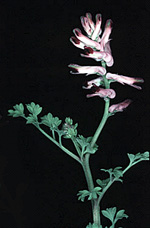 |
This is a family predominantly from the Northern Hemisphere temperate zone, represented in southern Australia only by naturalised, minor weeds. Several species of Fumaria may be common in gardens and moist disturbed places, while members of a few other genera are uncommon.
Characteristic features of the family Fumariaceae in Australia include: - soft, annual herbs or scramblers with watery sap and alternate, usually much divided leaves
- flowers axillary or in racemes, white, pink or yellow, usually highly zygomorphic (regular in Hypecoum), with 2 free sepals; uppermost petal in Fumaria conspicuously spurred
- stamens 6 in two bundles (or 4 and not bundled an Hypecoum)
- ovary superior, forming a small, dry nut (or capsule in Hypecoum)
Description
Annual, biennial or perennial herbaceous scrambling vines, or terrestrial herbs. Perennating by taproots or crowns. Internal secretions not obvious. Plants glabrous, or with simple, non-glandular, unicellular hairs. Leaves alternate and spiral; cauline or both basal and cauline, petiolate. Stipules absent. Lamina simple, bicompound or tricompound, imparipinnate, symmetric or conspicuously asymmetric, bipinnatifid, tripinnatifid, etc; lamina/leaflets filiform, acicular, subulate, linear, lanceolate, ovate, elliptic, oblanceolate or obovate; base cuneate, rounded or oblique; margins entire, crenate or serrate, ±flat; venation pinnate, with the midrib conspicuous or inconspicuous, and the tertiary venation reticulate or not; surfaces not punctate; herbaceous; distinctive odour absent or aromatic. All the flowers bisexual. Inflorescences terminal, axillary or leaf opposed, consisting of racemes, monochasial cymes or corymbs. Bracts present. Pollination by insects. Flowers odourless, stalked. Floral disc absent; nectaries present on the stamens. Perianth of 2 dissimilar whorls or all whorls ±similar. Calyx irregular; segments free, with 2 sepals, valvate or open in bud, herbaceous. Corolla regular or irregular; segments free or apparently fused, with 4 (–6) petals or lobes, alternating with or opposite the sepals, imbricate in bud; corolla 1 or 2-lipped or with palate, white, cream, pink, magenta or purple, streaked, spotted, etc, membranous; claws absent; lobes ±entire, or notched, emarginate, bifid, bilobed, trifid, trilobed or more divided; base with spurs, or without spurs, wings or other appendages. Fertile stamens 4 or 6, not clearly correlated with the sepals, free of the corolla, free of the ovary and style, distinct from each other, grouped or fused into bundles, fused by their filaments into an open or closed tube or fused by their anthers, all ±equal. Anthers basifixed, not versatile, opening inwards by longitudinal slits, 1- or 2-celled; appendages absent or apical. Ovary superior and sessile. Carpels 2, fused; ovary with 1 locule. Style terminal, single and unbranched, or branched above or from the base. Ovules 1–numerous, sessile; placentation parietal. Fruit a dry, dehiscent septicidal capsule or an indehiscent nut; the perianth on the maturing fruit deciduous. Disseminule micro-surface ±smooth or tuberculate, green or brown, glossy or dull. Seeds 1–10 per fruit. Aril present or absent. Cotyledons 2. Embryo curved.
(Note: this description has been generated from the coded data compiled for the key. Any errors in the key data will be reflected in the descriptions.)
A treatment of the family Fumariaceae has not yet been published in the Flora of Australia. It will appear in Volume 2.
Australian genera of Fumariaceae (as recognised for the Flora of Australia)
* = all species introduced
*Corydalis
*Fumaria
*Hypecoum
*Platycapnos

|
  |

Fumaria sp. (flowers)
Photo: M.Fagg © ANBG
|

| |